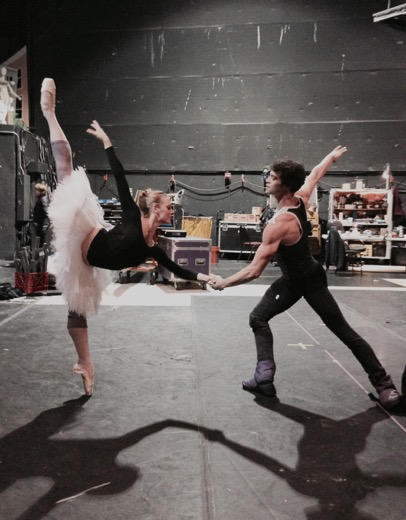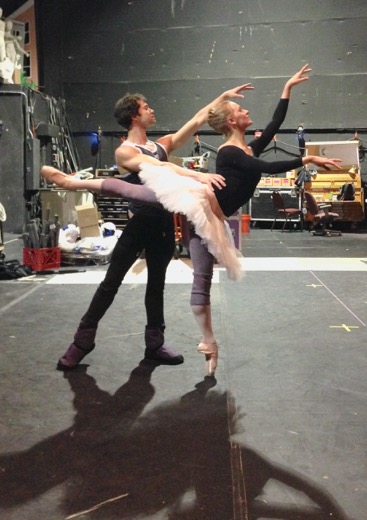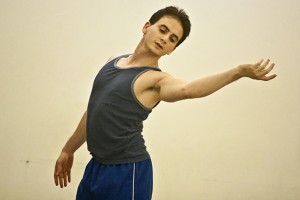
by Ashley Ellis
Boston Ballet’s upcoming program is titled Thrill of Contact, and it’s an amazing collection of ballets. Costumes range from Classical tutus to goofy hats—to dancers wearing socks. It’s an ideal program to display Boston Ballet at its best; showcasing the incredible power and range of styles that its dancers can achieve. It features works by Robbins and Forsythe, and a world premiere by Principal Dancer, Jeffrey Cirio.
It also includes George Balanchine’s Theme and Variations.
It is extremely gratifying to push myself to try and achieve the control and precision demanded by Balanchine’s choreography. In addition to the demands of the steps and musicality, there are stylistic details that are important to apply when dancing these ballets. They say that some of these stylistic changes surfaced when Mr. B would ask his dancers to do steps quicker than they were typically executed. Part of the fun of dancing Balanchine ballets is applying these details and “flares” that are particular to his choreography and are part of what makes it unique from that of any other choreographer.
At the moment I am preparing for the iconic Theme and Variations. My first experience with Theme was when I was 15 years old; I was chosen to dance an excerpt from the role for the final show at the ABT Summer Intensive. Although it was just a tidbit of the ballet, the experience really stuck with me. A couple of years passed and I got to be a part of the ballet as a whole, dancing one of the corps spots in ABT’s productions. This time around, I have the honor of dancing the principal role alongside my wonderful partner Paulo Arrais.
In Theme, the female variations are very short, but what it lacks in length is made up for in speed. I feel that my heart already needs to be beating overtime just to make my muscles react with the urgency and briskness needed. At first I found the variations to be intimidating; almost like little packages of anxiety when the music played; your legs and feet required to move so fast—all the while making it look like it’s easy. But as with other parts, you work on it and the steps start to feel more natural—and then you are able to apply the quality—like putting icing on a cake.

The second female variation goes directly into the pas de deux. This is difficult because you are so tired, but it almost doesn’t matter because the music is just so beautiful. I even remember the first time I heard the music during a show with ABT; when it began, my attention was immediately drawn to what was happening on the stage. There is something very unique about it.
I am not an expert on the Balanchine style, or his ballets. What I do know comes from what I have experienced while preparing for and dancing a selection of his wonderful works. His choreography demands a high level of technique and a strong sense of musicality. Both of these details are things that entice me. It is so much about the music, and in turn about the quality of how your execution of the steps embodies that music.
George Balanchine was one of the most influential choreographers of his time. He may even have been the most influential. I always find that I feel something special when dancing his ballets, and because of my long history with Theme, I know that performing this particular treasure will be very dear to me.
Boston Ballet presents Thrill of Contact, a striking program of precision and impressive athleticism featuring works by Balanchine, Robbins, Forsythe, and a world premiere by Principal Dancer, Jeffrey Cirio. It runs from May 14th – May 24th.
 Contributing writer Ashley Ellis is a principal dancer at Boston Ballet. Ellis hails from Torrance, California and she received her dance training at the South Bay Ballet under the direction of Diane Lauridsen. Other instruction included Alicia Head, Mario Nugara, Charles Maple, and Kimberly Olmos.
Contributing writer Ashley Ellis is a principal dancer at Boston Ballet. Ellis hails from Torrance, California and she received her dance training at the South Bay Ballet under the direction of Diane Lauridsen. Other instruction included Alicia Head, Mario Nugara, Charles Maple, and Kimberly Olmos.
She began her professional career with American Ballet Theatre’s Studio Company and later joined American Ballet Theatre as a company dancer. In 1999, Ellis won the first prize at the Los Angeles Music Center Spotlight Award, and went on to become the recipient of the Coca Cola scholarship award in 2000 and 2001. She has performed in Spain with Angel Corella’s touring group and joined Corella Ballet in 2008 as a soloist. In 2011, Ellis joined Boston Ballet as a second soloist. She was promoted to soloist in 2012 and principal dancer in 2013.
Her repertoire includes Marius Petipa’s The Sleeping Beauty; Mikko Nissinen’s The Nutcracker; Natalia Makarova’s La Bayadère; Marius Petipa’s Swan Lake; Christopher Wheeldon’s DGV: Danse à Grande Vitesse, VIII and Polyphonia; Harald Lander’s Études; Michel Fokine’s Les Sylphides; Rudolf Nureyev’s Don Quixote; Christopher Bruce’s Rooster; George Balanchine’s Serenade, Coppélia, Symphony in Three Movements, Symphony in C, and Tchaikovsky Pas de Deux; Clark Tippet’s Bruch Violin Concerto; Twyla Tharp’s In the Upper Room; Stanton Welch’s Clear; Angel Corella’s String Sextet; Wayne McGregor’s Chroma; Jorma Elo’s Awake Only; Jerome Robbins’ Fancy Free; Jiří Kylián’s Wings of Wax, Symphony of Psalms, and Petite Mort.







